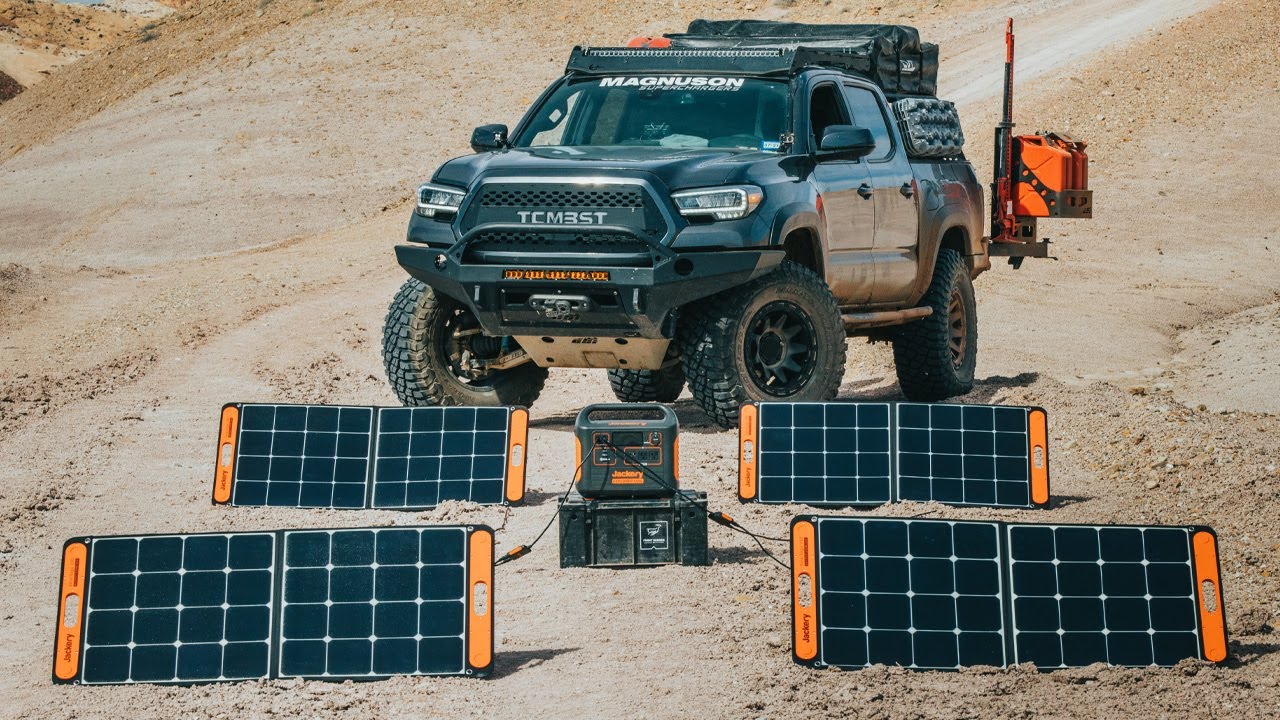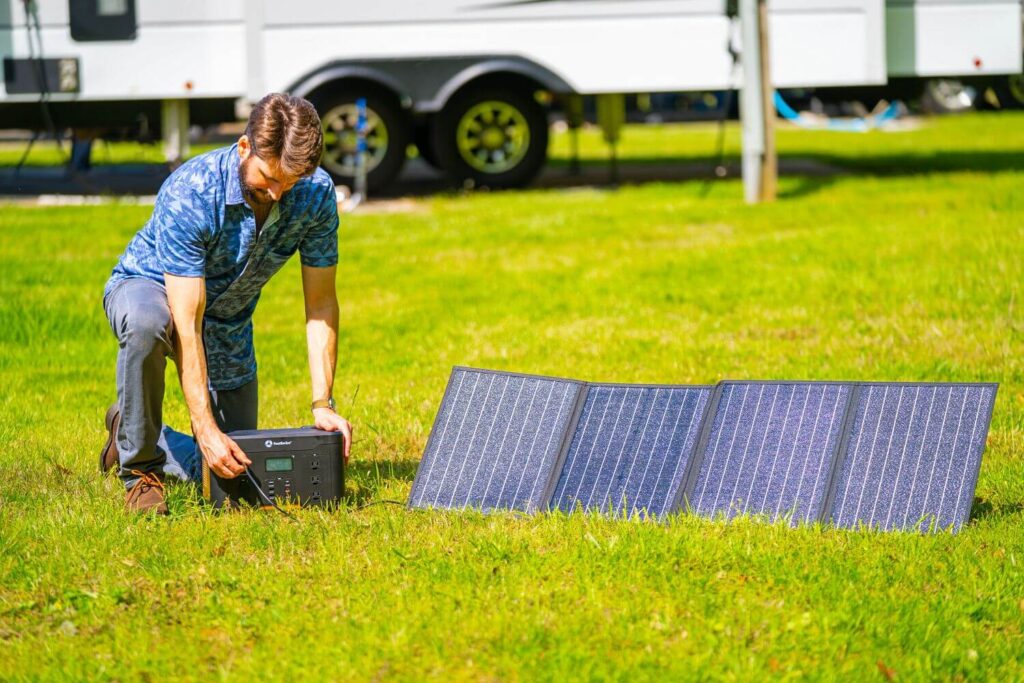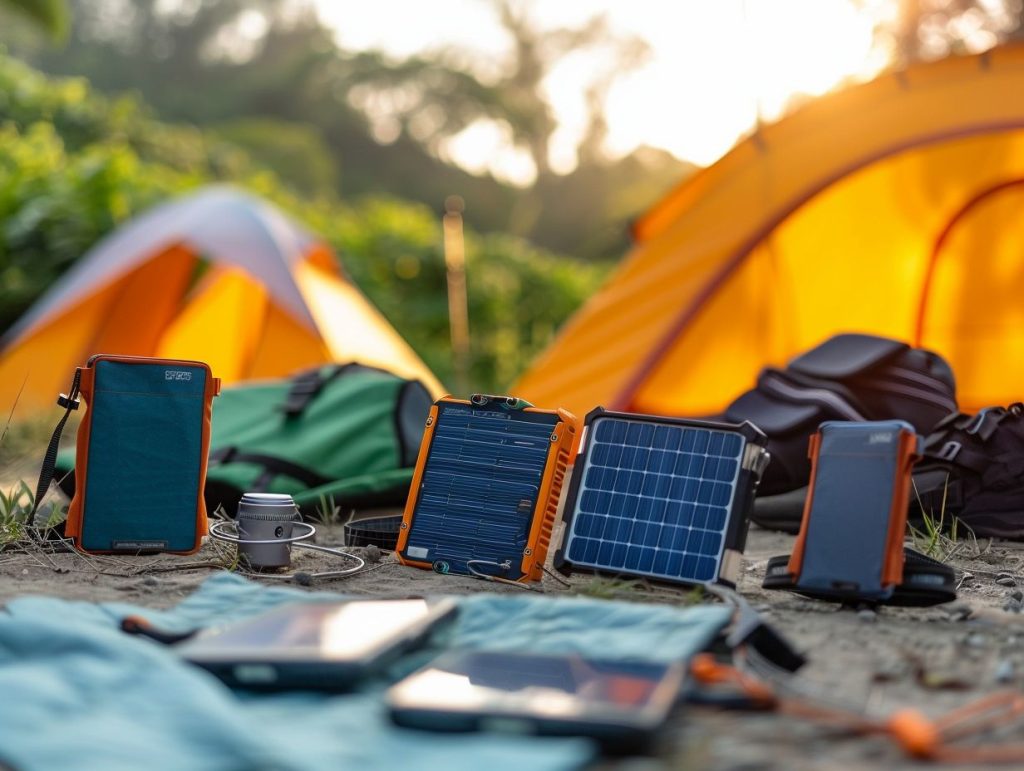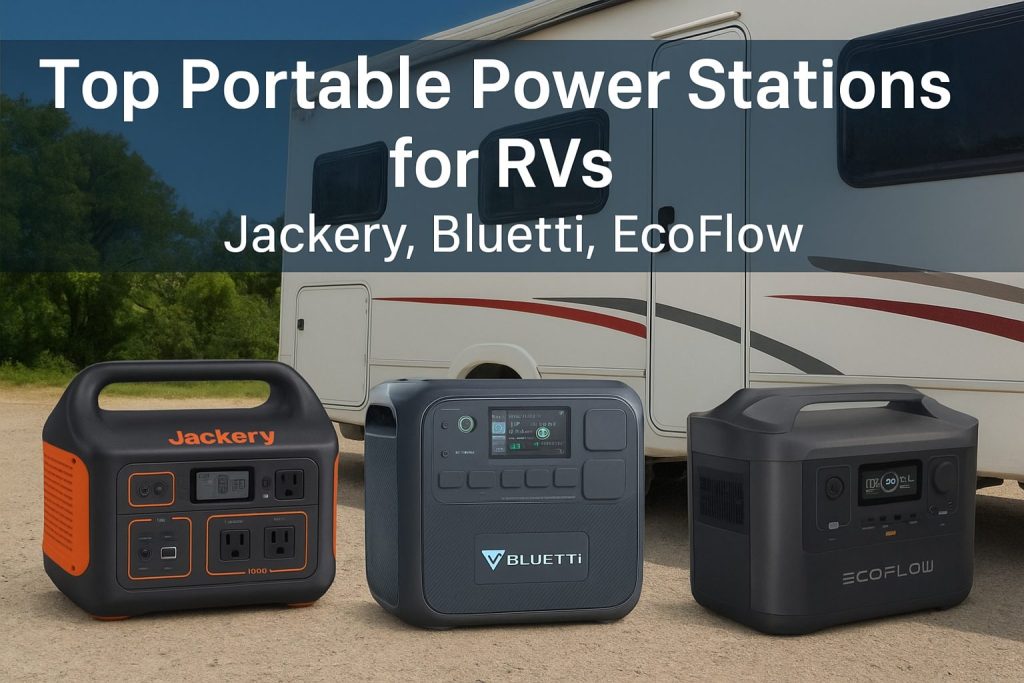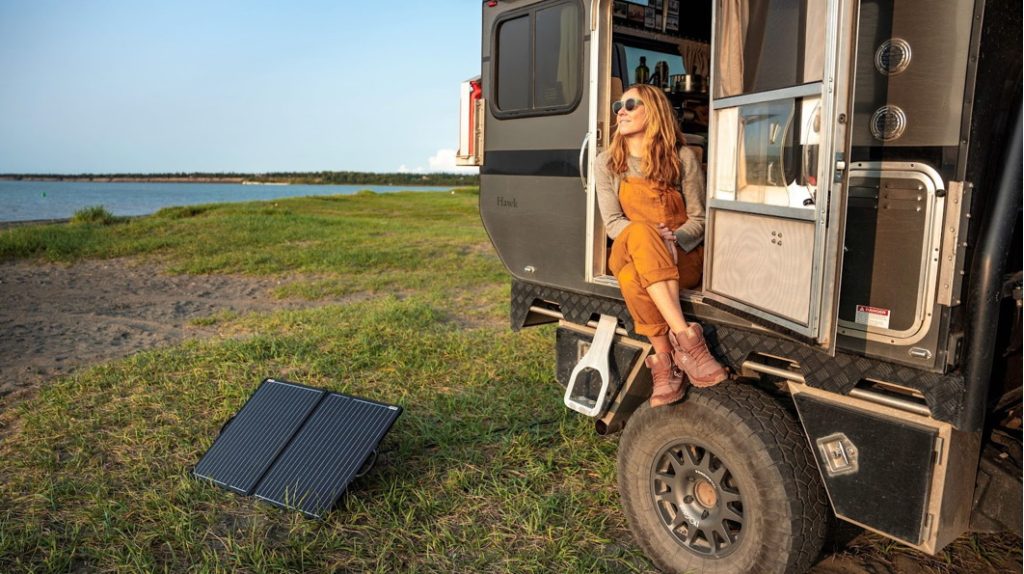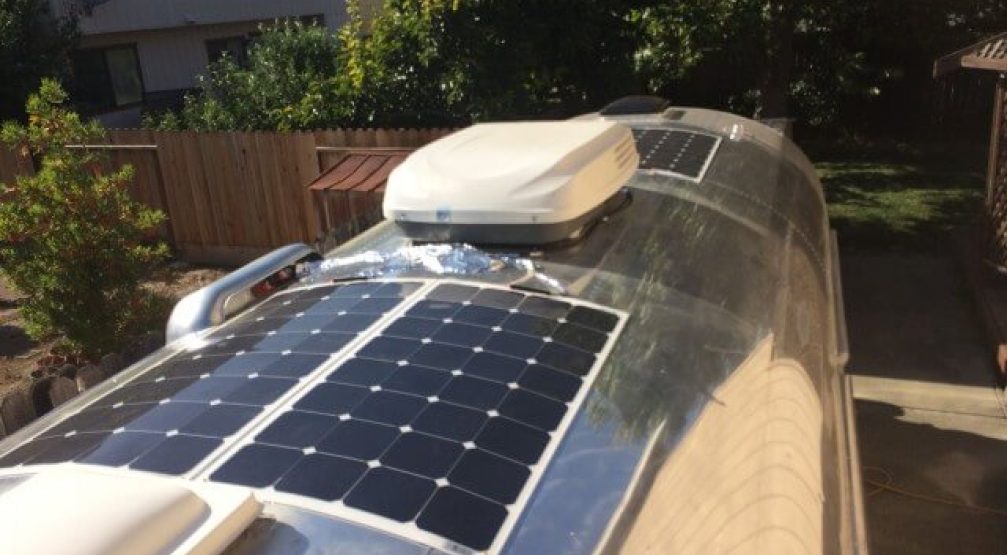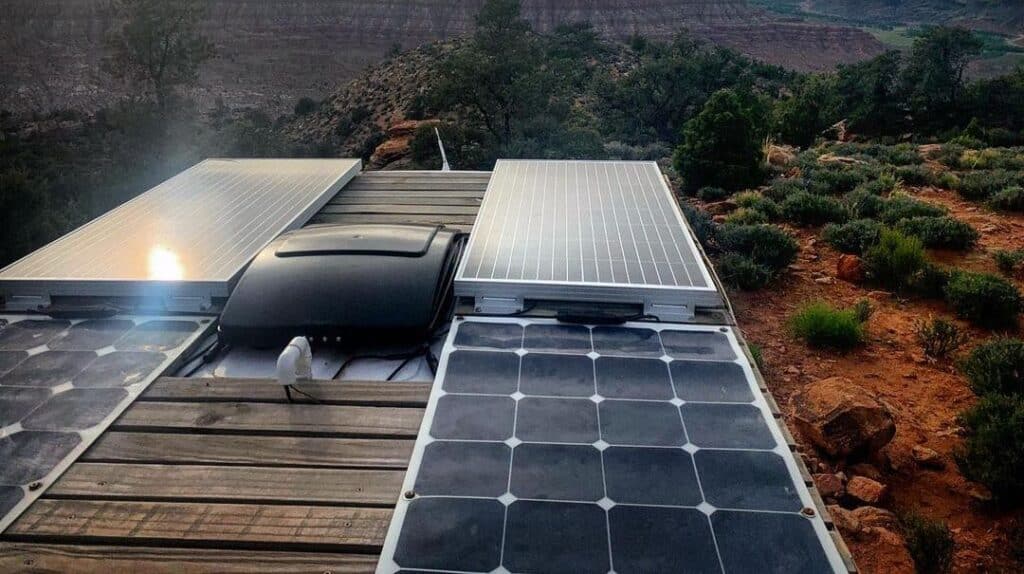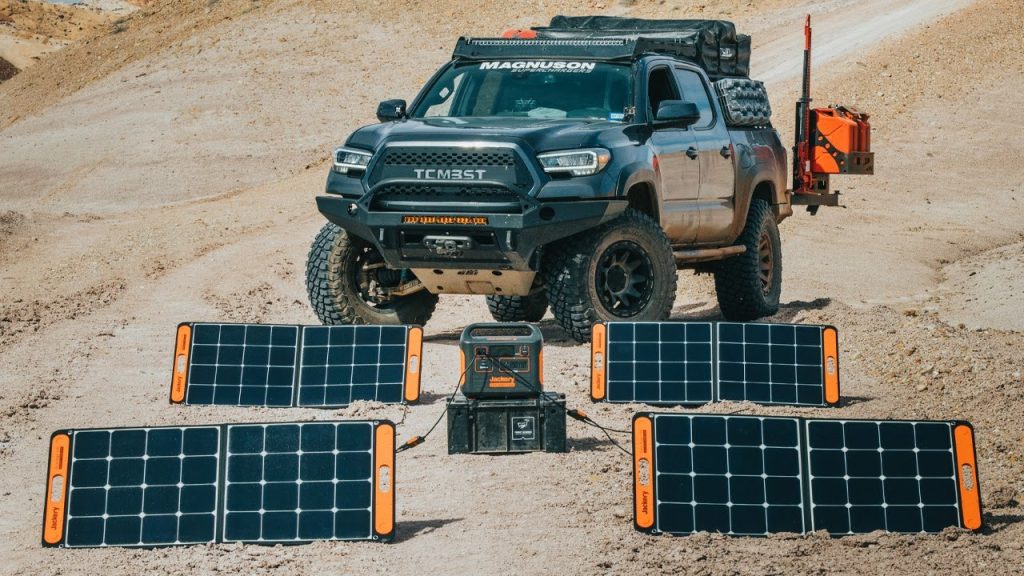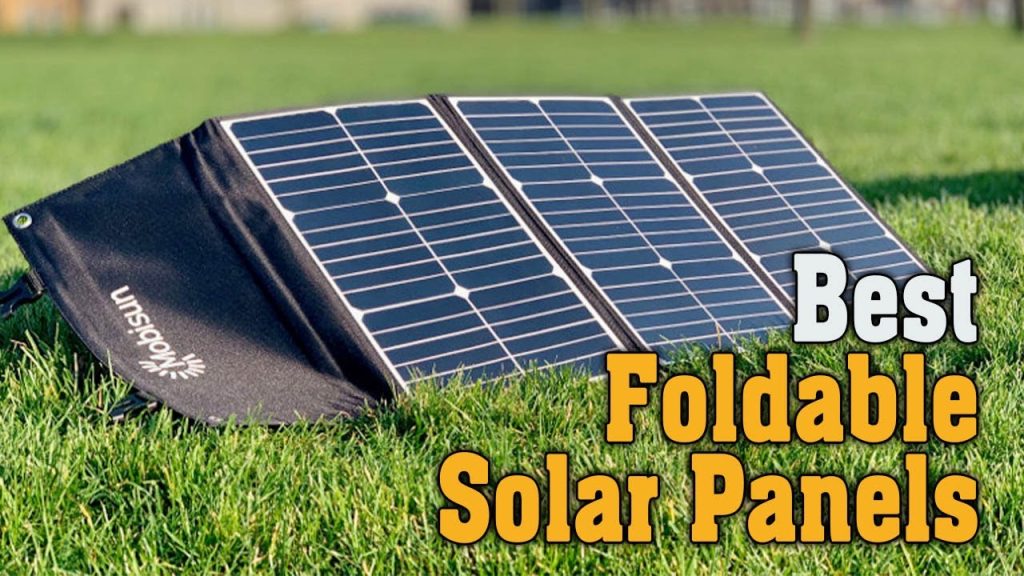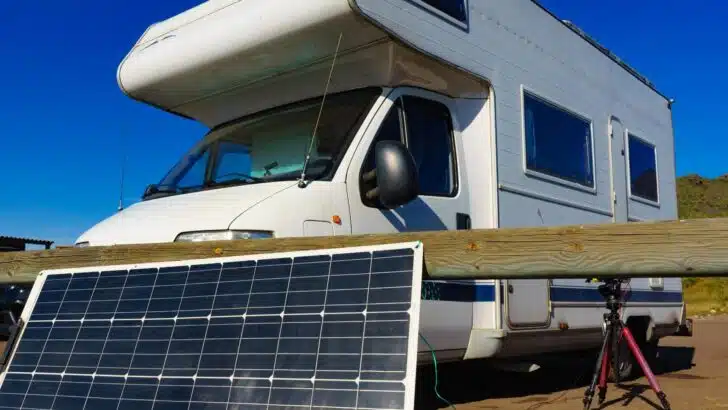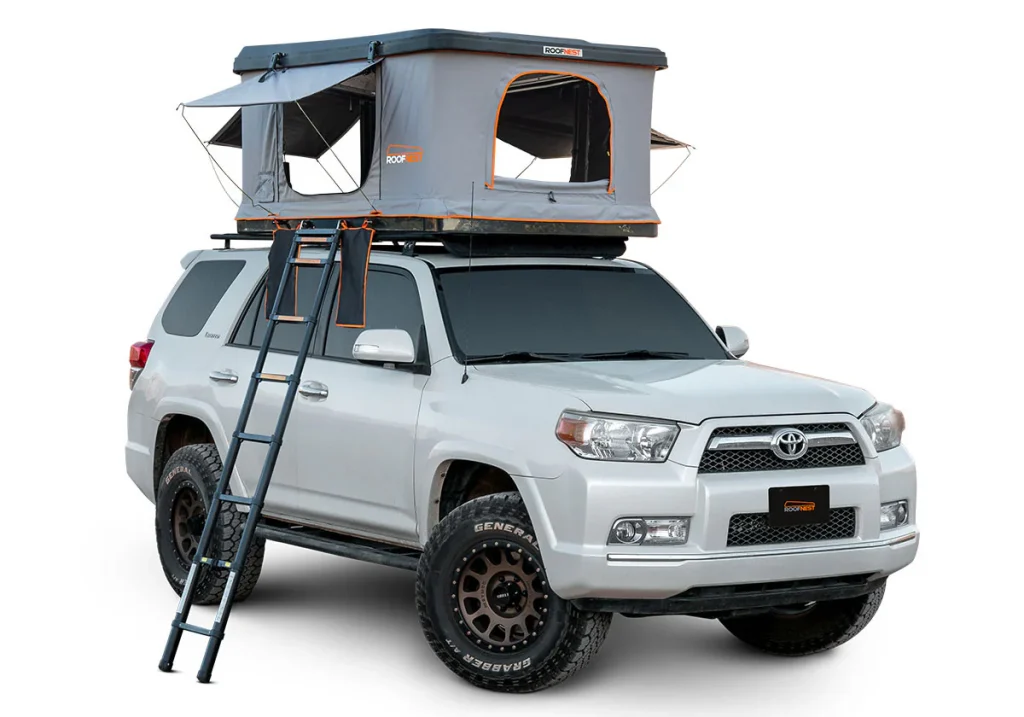Hook — Picture a quiet desert campsite at dusk: a low hum from a 12V fridge keeps your food cold, phones and cameras are topped up, the camp is lit by LEDs, and there’s no noisy gas generator breaking the silence. The power you need comes quietly from a compact solar generator and a fold-out panel on your roof rack.
One-sentence thesis — This post lists the best solar generators for overlanding, explains how to choose one, and reviews five top models for different budgets and trip styles.
Quick preview of the five products covered (one line each):
-
Jackery Explorer 300 — ultra-portable entry-level unit for short trips and device charging.
-
Jackery Explorer 1000 v2 — balanced mid-range option for weekend overlanders and small vans.
-
Jackery Explorer 2000 v2 — high-capacity solution for multi-day vanlife and heavier loads.
-
EcoFlow DELTA 2 — fast-charging unit with high solar acceptance, great for quick top-ups.
-
Anker SOLIX C1000 — LiFePO₄ chemistry, long cycle life, strong inverter for demanding users.
Top picks at a glance (comparison snapshot)
Notes before the table: the numbers below are approximate and intended to help readers compare sizes and use-cases quickly. Capacities (Wh) and inverter continuous outputs (W) are rounded and depend on SKU. Approx. Days for fridge is an estimate based on a fridge averaging 40 W continuous (≈960 Wh/day). Always check the manufacturer page for exact, current specs for the specific SKU you plan to buy.
| Product | Capacity (Wh) | Continuous AC (W) | Weight (approx.) | Approx. fridge runtime (40 W avg → ≈960 Wh/day) | Best for |
|---|---|---|---|---|---|
| Jackery Explorer 300 | 293 Wh | 300 W | ~7 lb | ~0.31 days (≈7.3 hours) | Ultralight / day trips / device charging |
| Jackery Explorer 1000 v2 | ~1,070 Wh | ~1,500 W | ~23–24 lb | ~1.11 days (≈26.8 hours) | Weekend overlanders / small vans |
| Jackery Explorer 2000 v2 | ~2,042 Wh | ~2,200 W | ~58–62 lb | ~2.13 days (≈51.0 hours) | Multi-day trips / vanlife / heavier loads |
| EcoFlow DELTA 2 | ~1,024 Wh | ~1,800 W | ~27 lb | ~1.07 days (≈25.6 hours) | Fast recharge / high solar input needs |
| Anker SOLIX C1000 | ~1,056 Wh | ~1,800 W | ~25–30 lb | ~1.10 days (≈26.4 hours) | Long battery life (LiFePO₄) / frequent use |
Quick picks — short bullets
-
Best budget pick: Jackery Explorer 300 — lowest weight and price for basic device charging and short trips.
-
Best for lightweight overlanders: Jackery Explorer 300 — tiny and very portable for minimalists.
-
Best for extended trips / vanlife: Jackery Explorer 2000 v2 — large capacity to power multiple appliances for days.
-
Best fast-charge / high solar-input: EcoFlow DELTA 2 — high solar acceptance and very fast recharge capabilities.
-
Best battery chemistry (cycle life and longevity): Anker SOLIX C1000 — LiFePO₄ cells for longer cycle life and robust thermal behavior.
How estimates were made
-
Fridge runtime estimates above assume an average fridge draw of 40 W continuous, which equals ≈960 Wh per 24-hour day (40 W × 24 h = 960 Wh).
-
Runtime = (Generator Wh) ÷ (960 Wh/day). Results rounded for readability; actual run-time depends heavily on fridge efficiency, ambient temperature, duty cycle, and how often the fridge door is opened.
-
Inverter continuous power and weight figures are typical values for the model families listed — check the exact SKU/spec page for certified numbers.
How to Choose a Solar Generator for Overlanding (Buyer’s Guide)
Selecting the best solar generators for overlanding is about finding the right balance between power capacity, portability, and recharge flexibility. Unlike stationary solar setups, overlanding requires gear that can withstand movement, vibration, heat, and occasional rough handling — while keeping your essentials powered day after day.
Below, we break down every factor you should consider before investing.
Understand the Basics: Wh vs. W — What They Mean and Why Both Matter
These two numbers define how powerful and how long your generator can perform:
-
W (Watts) measure power output — the rate at which energy is used. Think of it as the size of the “pipe” delivering power. For example, a generator rated at 1,000 W continuous can run a device that draws up to 1,000 W at once (like a small hairdryer or induction cooktop).
-
Wh (Watt-hours) measure energy capacity — the amount of stored energy. This determines how long your devices will run. A 1,000 Wh generator can theoretically run a 100 W load for about 10 hours (1,000 Wh ÷ 100 W = 10 h).
For overlanding:
-
Look for 300–500 Wh for short trips or just charging devices.
-
1,000–1,500 Wh suits weekend or 2–3 day off-grid stays with a small fridge.
-
2,000 Wh+ supports extended vanlife, multiple devices, or heavier appliances.
Typical Overlanding Loads (Realistic Daily Wh Estimates)
To size your generator, first calculate your daily consumption. Here are average values for common gear:
| Device | Typical Power (W) | Average Daily Use (hrs/day) | Daily Consumption (Wh) |
|---|---|---|---|
| Smartphone (charging) | 10 | 1 | 10 |
| Camera battery charger | 20 | 1 | 20 |
| Laptop (work hours) | 60 | 4 | 240 |
| 12V Fridge (40 W avg.) | 40 | 24 | 960 |
| LED lights (string/lanterns) | 20 | 5 | 100 |
| CPAP machine (with humidifier off) | 40 | 8 | 320 |
| Small induction/camp cooker | 1,200 | 0.5 | 600 |
Daily total example:
Fridge (960) + Laptop (240) + Lights (100) + Phone/Camera (30) = ≈1,330 Wh/day
That means a 1,000 Wh generator will last about ¾ of a day before needing a recharge. Add more capacity or solar input for extended stays.
Solar Input & Recharge Rate — Why They Determine How Long You’ll Stay Off-Grid
Even the largest battery runs out eventually. The ability to refill it daily with solar energy is what keeps you independent.
Key factors:
-
Solar input wattage limit (generator’s MPPT rating): This determines how much solar you can plug in. For instance, the EcoFlow DELTA 2 accepts up to 500 W, while smaller Jackery units may accept 100–200 W.
-
Solar panel wattage: Real-world performance averages 70–80 % of the panel’s rated wattage due to sun angle, dust, and temperature.
-
Sun hours per day: 4–6 hours of strong sunlight is typical in good conditions.
Example:
A 200 W panel × 5 hours × 0.8 efficiency ≈ 800 Wh/day recharge potential.
That’s enough to refill most mid-size generators daily or maintain a small fridge indefinitely.
Tip: Choose a generator whose solar input (W) matches or slightly exceeds your expected panel array. More input = faster turnaround and less downtime.
Battery Chemistry: Li-ion vs. LiFePO₄ — Cycle Life, Weight, and Safety
| Feature | Standard Li-ion (NMC) | LiFePO₄ (LFP) |
|---|---|---|
| Cycle life (to 80 % capacity) | ~500–800 cycles | ~3,000–6,000 cycles |
| Weight (for same Wh) | Slightly lighter | Slightly heavier |
| Safety / thermal stability | Good, but can overheat under abuse | Excellent — far more temperature tolerant |
| Cost | Usually cheaper | Slightly more expensive |
| Cold weather performance | Better at low temps | Moderate; keep warm for best results |
In short:
If you plan frequent use (vanlife, long expeditions), LiFePO₄ (LFP) is worth it for longevity and safety. If you use it only occasionally, standard Li-ion (NMC) is fine and lighter.
Weight, Portability, and Mounting Considerations for Vehicles
Solar generators vary from under 10 lb to over 60 lb.
-
Under 10 lb: extremely portable; ideal for short overland trips or tent camping.
-
20–30 lb: manageable one-person lift; common for 1 kWh units.
-
50 lb+: heavy; best secured inside a van, trailer, or pickup bed.
Mounting tips:
-
Secure large generators in padded crates or straps to reduce vibration.
-
Keep airflow open for cooling fans.
-
Avoid leaving units in direct sun inside vehicles — heat shortens battery life.
-
For quick access, position AC/DC ports near your fridge or electronics hub.
Ports & Features to Watch For
A good overlanding power station should include:
-
USB-C PD (60–100 W) for laptops, tablets, and drones.
-
Multiple AC outlets for appliances.
-
12 V car socket for fridges or inflators.
-
Pass-through charging, so it can charge and discharge simultaneously (handy while driving).
-
App connectivity (Wi-Fi/Bluetooth) for monitoring battery %, input/output, and remote on/off.
-
Fast-charging modes (AC or solar) for quick turnarounds between drives.
-
Pure sine wave inverter — safer for sensitive electronics.
Expandability & Ecosystem
Not all generators grow with your needs.
Look for systems offering:
-
Expansion batteries (e.g., EcoFlow DELTA 2’s extra packs).
-
Dedicated solar panels and cables from the same brand (guaranteed compatibility).
-
Vehicle charging options, such as DC-to-DC car adapters or Anderson plug setups.
-
Firmware/app updates, extending product life and adding features.
Tip: Staying within one ecosystem (Jackery, EcoFlow, Anker, etc.) ensures plug-and-play reliability — especially when adding accessories later.
Budget & Total System Cost
When planning your overlanding power setup, don’t consider the generator alone — include the full ecosystem:
| Component | Typical Cost Range (USD) | Notes |
|---|---|---|
| Solar generator (300–2,000 Wh) | $300–$1,900 | Core power unit |
| Solar panels (100–400 W total) | $150–$700 | Higher wattage = faster recharge |
| Cables, adapters, mounts | $50–$150 | Ensure waterproof and proper connectors |
| Storage/protection case | $40–$100 | Especially important for dust & vibration |
| Optional expansion battery | $300–$800 | Brand-specific compatibility |
Pro tip: It’s often smarter to buy an official bundle (generator + panels) from Amazon or the manufacturer — it guarantees matching connectors and saves 10–20 % compared to buying separately.
In-Depth Reviews — The 5 Best Solar Generators for Overlanding
This section dives into detailed reviews of the five best solar generators for overlanding—analyzing their power specs, performance, portability, and real-world practicality. Each model suits a different overlanding style, from minimalist setups to full off-grid rigs.
#1 — Jackery Explorer 300 Portable Power Station
The Jackery Explorer 300 is a lightweight, entry-level solar generator built for short trips, weekend adventures, and essential off-grid electronics. Compact and dependable, it’s perfect for overlanders who value simplicity and portability over high power capacity.
Key Specifications
- Battery Capacity: 293 Wh (Lithium-ion NMC)
- Continuous AC Output: 300 W (surge 500 W)
- Weight: ~7.1 lbs (3.2 kg)
- Dimensions: 9.1 × 5.2 × 7.8 in
- Ports: 2× AC, 1× USB-C (60W PD), 1× USB-A, 1× QC 3.0, 1× 12V car port
- Solar Input: 100W max (MPPT controller)
Pros
- Extremely portable — fits easily in small storage spaces
- Fast recharge from AC or solar (≈2 hours via wall)
- USB-C PD output supports laptops and cameras
- Reliable brand with excellent customer support
- Great for phones, lights, cameras, and small devices
Cons
- Limited battery capacity for larger appliances
- No expandable battery option
- Small inverter limits high-load usage
#2 — Jackery Explorer 1000 v2 Portable Power Station
The Jackery Explorer 1000 v2 is a versatile mid-range solar generator offering reliable off-grid power for RVers, overlanders, and campers. It delivers enough energy to run fridges, lights, fans, and multiple devices without sacrificing portability.
Key Specifications
- Battery Capacity: ~1,070 Wh (Li-ion NMC)
- Continuous AC Output: 1,500 W (surge 3,000 W)
- Weight: ~23.2 lbs (10.5 kg)
- Dimensions: 13.4 × 10.1 × 10.3 in
- Ports: 3× AC, 2× USB-C (100W PD), 2× USB-A, 1× 12V car port
- Solar Input: Up to 400W (MPPT)
Pros
- Excellent power-to-weight ratio
- Can run a 12V fridge for 24+ hours
- Fast solar recharge (≈2 hrs with dual 200W panels)
- Durable design with ergonomic handle
- Quiet, clean operation — ideal for remote camps
Cons
- Li-ion NMC offers fewer charge cycles than LiFePO₄
- No expansion battery support
- Not fully weather-sealed or ruggedized
#3 — Jackery Explorer 2000 v2 Portable Power Station
The Jackery Explorer 2000 v2 is designed for serious overlanders, vanlifers, and long expeditions. With over 2 kWh of energy storage, it can power high-demand devices like induction cooktops, air conditioners, or medical gear with ease.
Key Specifications
- Battery Capacity: ~2,042 Wh (Li-ion NMC)
- Continuous AC Output: 2,200 W (surge 4,400 W)
- Weight: ~61.5 lbs (27.9 kg)
- Dimensions: 15.1 × 10.5 × 12.1 in
- Ports: 3× AC, 2× USB-C, 2× USB-A, 1× 12V car port
- Solar Input: Up to 1,200W (supports triple SolarSaga panels)
Pros
- Massive 2 kWh capacity — supports multi-day trips
- Can run heavy appliances and tools
- Triple-panel solar setup support (up to 1,200W)
- Built-in dual MPPT controller ensures efficient charging
- Proven performance in demanding conditions
Cons
- Heavy and bulky — best for vans or stationary setups
- High upfront cost
- Still uses NMC chemistry (shorter lifespan vs LiFePO₄)
#4 — EcoFlow DELTA 2 Portable Power Station
The EcoFlow DELTA 2 is a next-generation portable power station built for speed, efficiency, and longevity. It’s perfect for overlanders who need to recharge quickly between drives or depend on solar input during long expeditions.
Key Specifications
- Battery Capacity: ~1,024 Wh (LiFePO₄)
- Continuous AC Output: 1,800 W (surge 2,700 W)
- Weight: ~27 lbs (12.2 kg)
- Dimensions: 15.7 × 8.3 × 11 in
- Ports: 6× AC, 2× USB-C (100W PD), 2× USB-A, DC car port
- Solar Input: Up to 500W (11–60V, 15A max)
- Recharge Time: ≈50 minutes (AC to 80%)
Pros
- Ultra-fast AC recharge — 80% in under an hour
- High solar input capacity (up to 500W)
- LiFePO₄ chemistry ensures long lifespan (3,000+ cycles)
- Expandable to 2,048 Wh with extra battery
- App monitoring and smart power management
Cons
- Heavier than comparable 1 kWh models
- Premium pricing for advanced features
- Fan noise noticeable at high output
#5 Anker SOLIX C1000 – Compact, Durable & Long-Life Power Station

The Anker SOLIX C1000 combines durability, LiFePO₄ longevity, and smart design in a compact form. It’s ideal for overlanders who demand high cycle life and solid inverter performance for daily or frequent use. With ultra-fast recharging, rugged construction, and quiet operation, it’s a dependable companion for extended off-grid trips.
- Battery Capacity: ~1,056 Wh (LiFePO₄)
- Continuous AC Output: 1,800 W (surge 2,400 W)
- Weight: ~28.4 lbs (12.9 kg)
- Dimensions: 15.3 × 8.9 × 10.5 in
- Ports: 6× AC, 2× USB-C (100W PD), 2× USB-A, 1× car outlet
- Solar Input: Up to 600W (MPPT)
- Recharge Time: ~58 minutes (AC to 80%)
- LiFePO₄ battery — 3,000+ cycle life, stable and safe
- Fast AC recharge and efficient solar charging
- Rugged design with well-placed handles for mobility
- Quiet operation and strong inverter for power-hungry devices
- Anker’s reliable ecosystem and support network
- Premium price tag for a 1 kWh-class unit
- Requires additional solar panels for multi-day off-grid stays
- Limited official expansion options (no extra battery yet)
Side-by-side deep comparison (visual + analysis)
Below is a compact comparison of the five models covered in this post so you can scan core specs at a glance. Numbers are approximate and SKU-dependent — always verify the exact model page before purchase.
| Product | Capacity (Wh) | Inverter cont. (W) | Surge (W) | Weight (lb) | Solar input max (W) | Battery chemistry | Est. price range (USD) |
|---|---|---|---|---|---|---|---|
| Jackery Explorer 300 | 293 | 300 | 500 | ~7.1 | 100 | Li-ion (NMC) | $200–$350 |
| Jackery Explorer 1000 v2 | ~1,070 | 1,500 | 3,000 | ~23 | up to 400 | Li-ion (NMC) | $800–$1,200 |
| Jackery Explorer 2000 v2 | ~2,042 | 2,200 | 4,400 | ~61.5 | up to 1,200 | Li-ion (NMC) | $1,800–$2,500 |
| EcoFlow DELTA 2 | ~1,024 | 1,800 | 2,700 | ~27 | up to 500 | LiFePO₄ (LFP) | $900–$1,300 |
| Anker SOLIX C1000 | ~1,056 | 1,800 | 2,400 | ~28.4 | up to 600 | LiFePO₄ (LFP) | $900–$1,400 |
Quick interpretive notes — best models for common scenarios
-
Single-day / ultralight trips: Jackery Explorer 300 — extremely portable for device charging and short stays.
-
Weekend (2–3 days) overlanding: Jackery Explorer 1000 v2 or EcoFlow DELTA 2 — enough capacity for a fridge and devices with moderate solar topping.
-
Multi-day or vanlife: Jackery Explorer 2000 v2 — high capacity to run fridges, CPAPs, and occasional cooking.
-
Frequent use / daily reliance: EcoFlow DELTA 2 or Anker SOLIX C1000 — LFP chemistry and fast recharge are ideal when you use a power station every trip.
Sizing examples & calculators (mini DIY)
Below are two worked examples so you can see how to size a generator + panel combination. I’ll also give the formulas you can reuse.
Formula — total daily energy (Wh):
Total Wh/day = ∑ (device watt × hours used per day)
Rule of thumb — how many solar watts you need to sustain X Wh/day:
Solar watts needed ≈ Daily Wh ÷ (Sun hours × System efficiency)
(Use system efficiency ≈ 0.75–0.85 to account for angle, heat, wiring losses; we’ll use 0.8 for examples.)
Example 1 — Solo overlander, 3-day weekend
Assumed daily loads:
-
12V fridge — 40 W average × 24 h = 960 Wh/day
-
Laptop — 60 W × 4 h = 240 Wh/day
-
LED lights — 10 W × 5 h = 50 Wh/day
-
Phone + camera charging — 10 + 10 = 20 Wh/day
Daily total: 960 + 240 + 50 + 20 = 1,260 Wh/day
3-day need: 1,260 × 3 = 3,780 Wh
Option (practical): Jackery Explorer 2000 v2 (≈2,042 Wh) + portable solar array 500 W with ~5 effective sun hours/day.
-
Solar production estimate per day = 500 W × 5 h × 0.8 efficiency = 2,000 Wh/day.
-
Over 3 days solar would provide ≈ 6,000 Wh; combined with the generator initial capacity that’s more than enough (it yields considerable margin for cloudy periods or extra use).
Reasoning: the generator provides immediate stored energy (2,042 Wh). The 500 W array replenishes energy each day and over 3 days supplies additional ~6,000 Wh, covering the 3,780 Wh needed with room to spare.
Example 2 — Couple vanlife for 7 days (fridge + lights + laptop + coffee maker)
Assumed daily loads:
-
Fridge — 960 Wh/day
-
Lights & misc — 100 Wh/day
-
Laptop (two users share) — 240 Wh/day
-
Coffee maker (e.g., 1,200 W used 0.2 h/day) — 1,200 × 0.2 = 240 Wh/day
Daily total: 960 + 100 + 240 + 240 = 1,540 Wh/day
7-day need: 1,540 × 7 = 10,780 Wh
How much solar to sustain 1,540 Wh/day?
Solar_watts_needed = 1,540 ÷ (sun_hours × 0.8).
If sun_hours = 5 → Solar_watts_needed = 1,540 ÷ (5 × 0.8) = 1,540 ÷ 4 = 385 W.
Recommendation: plan ≈400–600 W of solar and a large-capacity generator such as the Jackery Explorer 2000 v2 (2,042 Wh) or pair a 1,000 Wh class unit with very large solar and/or a second generator/battery. You’ll also want to prioritize LFP chemistry if you run daily long-term (EcoFlow DELTA 2 or Anker SOLIX C1000) because of higher cycle life.
Pairing solar panels, cables & mounting tips
-
Rigid vs. flexible panels:
-
Rigid (crystalline) panels are more efficient and durable for permanent rooftop installs. They’re heavier and require roof racks and mounting brackets.
-
Flexible panels weigh less, conform to curved roofs but are less efficient and more heat-sensitive. Use for tight spaces where weight/flexibility matters.
-
Portable folding panels are great for campsite deployment — you can aim them and store them when driving.
-
-
MPPT charge controllers & integrated MPPT:
-
An integrated MPPT in the generator optimizes charging and accepts higher panel wattages safely. A generator with higher solar input (EcoFlow / Anker options) means faster recharges.
-
-
Cables, connectors & safety:
-
Use correct MC4 or brand-specific connectors and keep extension runs short. Include inline fuses sized to panel current, and use weatherproof junctions.
-
Label cables and secure them to prevent chafing.
-
-
Mounting tips:
-
Roof panels should be tilted at camp to increase production; use tilt brackets where possible.
-
Secure panels against theft — lockable mounts or always pack them when leaving camp.
-
Real-world tips for overlanding power management
-
Conserve first: set fridges to eco modes, use efficient LED lighting, and prefer DC loads (12V fridges) over inefficient AC conversions.
-
Charging etiquette: plug into solar while parked and charge from alternator while driving if your setup supports DC-to-DC charging. This spreads energy intake across travel and daylight.
-
Temperature care: batteries lose capacity in extreme cold and degrade in extreme heat. Insulate in winter and keep out of direct midday sun in hot climates.
-
Security: lock large units in the vehicle, chain portable panels to racks, and keep small units in a concealed storage box when not in use.
Frequently Asked Questions (FAQ) — short answers
-
Can I run a 12V fridge? Yes — a modern efficient 12V fridge averaging ~40 W can run from any of these units; how long depends on the generator Wh. Example: a 1,024 Wh pack running a 40 W fridge gives ~25.6 hours (1,024 ÷ 40).
-
How many panels to recharge 1,000 Wh in a day? With 5 sun hours and 0.8 efficiency: solar watts ≈ 1,000 ÷ (5 × 0.8) = 250 W. So two 150–200 W panels are a good baseline.
-
Safe to store in hot cars? Avoid leaving packs in closed cars in direct sun — high temps shorten battery life. Store in shaded, ventilated areas.
-
Difference between inverter W and battery Wh? Inverter W = how much power you can draw at once (peak device power). Battery Wh = how long you can sustain loads.
-
Can I expand capacity? Some brands (EcoFlow) support add-on batteries; others do not — check expandability before buying.
Final verdict & best picks by use-case
-
Best budget / lightweight: Jackery Explorer 300 — tiny, portable, $-friendly.
-
Best mid-range: Jackery Explorer 1000 v2 — balanced capacity and portability for weekend overlanders.
-
Best high-capacity: Jackery Explorer 2000 v2 — long runtimes for vanlife and multi-day trips.
-
Best fast-charging / high solar acceptance: EcoFlow DELTA 2 — fast AC recharge and high solar input.
-
Best long-life battery: Anker SOLIX C1000 — LiFePO₄ chemistry for thousands of cycles.
Wrap-up (one line): Choosing the best solar generators for overlanding comes down to matching real Wh/day needs, inverter demands, and realistic solar input — the right combo powers your trips quietly, cleanly, and reliably.
Read More: Best Foldable Solar Panels for Overlanding

